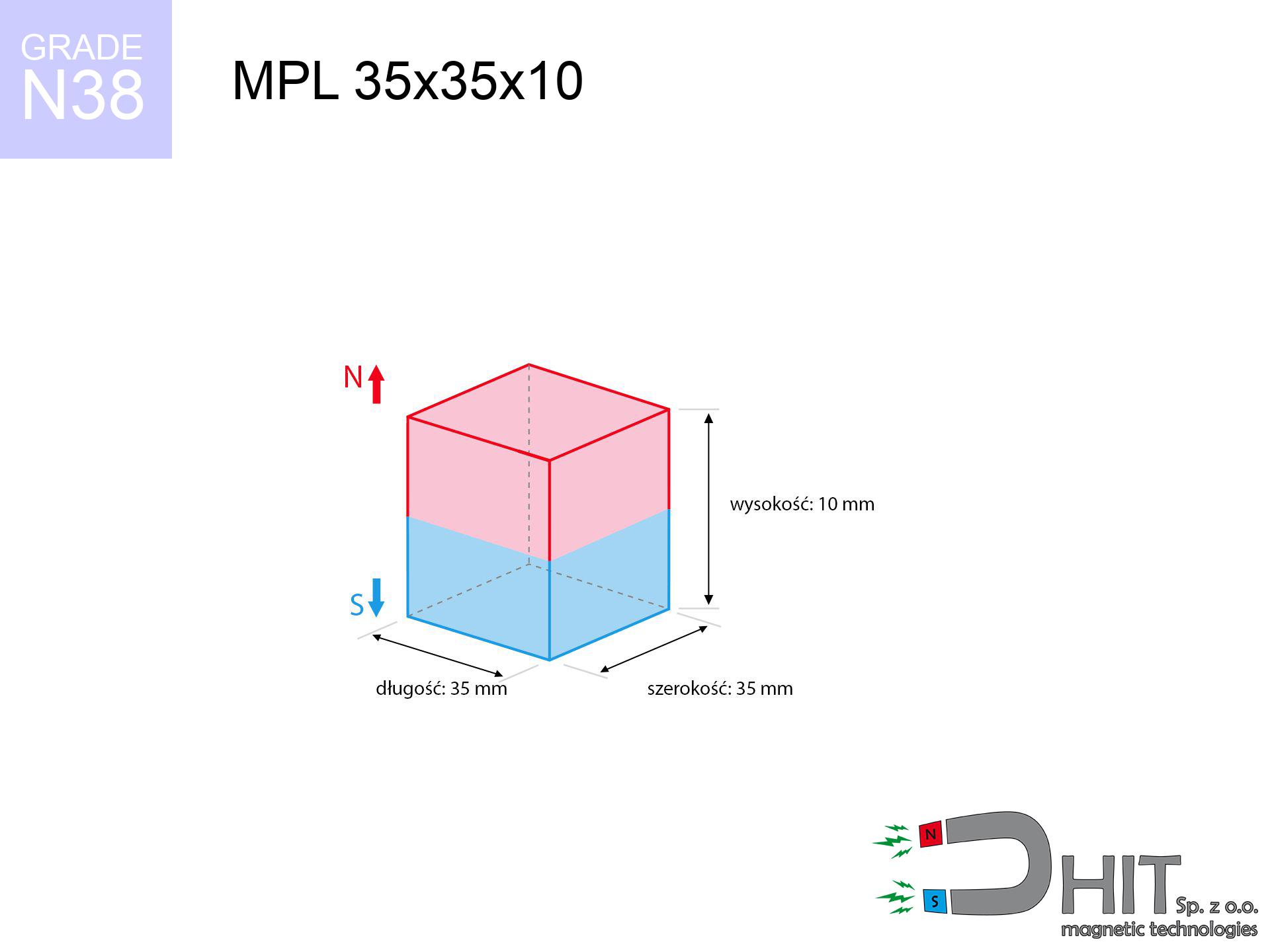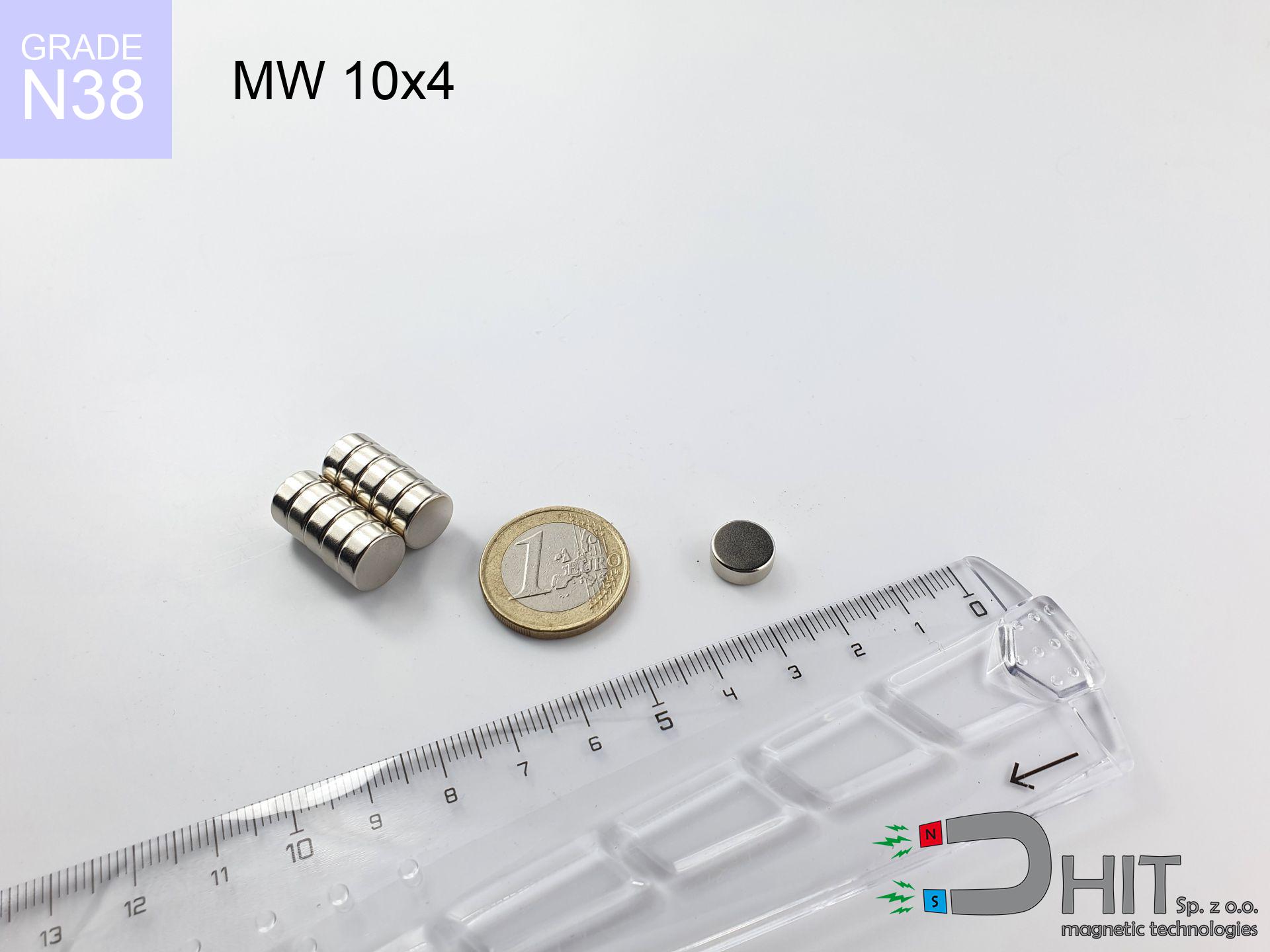MPL 35x35x10 / N38 - lamellar magnet
lamellar magnet
Catalog no 020144
GTIN/EAN: 5906301811503
length
35 mm [±0,1 mm]
Width
35 mm [±0,1 mm]
Height
10 mm [±0,1 mm]
Weight
91.88 g
Magnetization Direction
↑ axial
Load capacity
26.88 kg / 263.71 N
Magnetic Induction
282.90 mT / 2829 Gs
Coating
[NiCuNi] Nickel
35.10 ZŁ with VAT / pcs + price for transport
28.54 ZŁ net + 23% VAT / pcs
bulk discounts:
Need more?Not sure what to buy?
Call us now
+48 888 99 98 98
otherwise drop us a message using
our online form
the contact section.
Parameters and form of magnets can be analyzed on our
modular calculator.
Same-day shipping for orders placed before 14:00.
MPL 35x35x10 / N38 - lamellar magnet
Specification / characteristics MPL 35x35x10 / N38 - lamellar magnet
| properties | values |
|---|---|
| Cat. no. | 020144 |
| GTIN/EAN | 5906301811503 |
| Production/Distribution | Dhit sp. z o.o. |
| Country of origin | Poland / China / Germany |
| Customs code | 85059029 |
| length | 35 mm [±0,1 mm] |
| Width | 35 mm [±0,1 mm] |
| Height | 10 mm [±0,1 mm] |
| Weight | 91.88 g |
| Magnetization Direction | ↑ axial |
| Load capacity ~ ? | 26.88 kg / 263.71 N |
| Magnetic Induction ~ ? | 282.90 mT / 2829 Gs |
| Coating | [NiCuNi] Nickel |
| Manufacturing Tolerance | ±0.1 mm |
Magnetic properties of material N38
| properties | values | units |
|---|---|---|
| remenance Br [min. - max.] ? | 12.2-12.6 | kGs |
| remenance Br [min. - max.] ? | 1220-1260 | mT |
| coercivity bHc ? | 10.8-11.5 | kOe |
| coercivity bHc ? | 860-915 | kA/m |
| actual internal force iHc | ≥ 12 | kOe |
| actual internal force iHc | ≥ 955 | kA/m |
| energy density [min. - max.] ? | 36-38 | BH max MGOe |
| energy density [min. - max.] ? | 287-303 | BH max KJ/m |
| max. temperature ? | ≤ 80 | °C |
Physical properties of sintered neodymium magnets Nd2Fe14B at 20°C
| properties | values | units |
|---|---|---|
| Vickers hardness | ≥550 | Hv |
| Density | ≥7.4 | g/cm3 |
| Curie Temperature TC | 312 - 380 | °C |
| Curie Temperature TF | 593 - 716 | °F |
| Specific resistance | 150 | μΩ⋅cm |
| Bending strength | 250 | MPa |
| Compressive strength | 1000~1100 | MPa |
| Thermal expansion parallel (∥) to orientation (M) | (3-4) x 10-6 | °C-1 |
| Thermal expansion perpendicular (⊥) to orientation (M) | -(1-3) x 10-6 | °C-1 |
| Young's modulus | 1.7 x 104 | kg/mm² |
Technical analysis of the product - data
These data are the result of a physical analysis. Results are based on models for the class Nd2Fe14B. Real-world conditions may differ from theoretical values. Please consider these calculations as a supplementary guide during assembly planning.
MPL 35x35x10 / N38
| Distance (mm) | Induction (Gauss) / mT | Pull Force (kg) | Risk Status |
|---|---|---|---|
| 0 mm |
2829 Gs
282.9 mT
|
26.88 kg / 26880.0 g
263.7 N
|
critical level |
| 1 mm |
2727 Gs
272.7 mT
|
24.98 kg / 24982.7 g
245.1 N
|
critical level |
| 2 mm |
2613 Gs
261.3 mT
|
22.94 kg / 22939.0 g
225.0 N
|
critical level |
| 3 mm |
2491 Gs
249.1 mT
|
20.84 kg / 20841.0 g
204.4 N
|
critical level |
| 5 mm |
2232 Gs
223.2 mT
|
16.73 kg / 16730.5 g
164.1 N
|
critical level |
| 10 mm |
1600 Gs
160.0 mT
|
8.60 kg / 8600.7 g
84.4 N
|
warning |
| 15 mm |
1102 Gs
110.2 mT
|
4.08 kg / 4082.9 g
40.1 N
|
warning |
| 20 mm |
757 Gs
75.7 mT
|
1.93 kg / 1925.7 g
18.9 N
|
weak grip |
| 30 mm |
376 Gs
37.6 mT
|
0.48 kg / 475.7 g
4.7 N
|
weak grip |
| 50 mm |
122 Gs
12.2 mT
|
0.05 kg / 49.9 g
0.5 N
|
weak grip |
MPL 35x35x10 / N38
| Distance (mm) | Friction coefficient | Pull Force (kg) |
|---|---|---|
| 0 mm | Stal (~0.2) |
5.38 kg / 5376.0 g
52.7 N
|
| 1 mm | Stal (~0.2) |
5.00 kg / 4996.0 g
49.0 N
|
| 2 mm | Stal (~0.2) |
4.59 kg / 4588.0 g
45.0 N
|
| 3 mm | Stal (~0.2) |
4.17 kg / 4168.0 g
40.9 N
|
| 5 mm | Stal (~0.2) |
3.35 kg / 3346.0 g
32.8 N
|
| 10 mm | Stal (~0.2) |
1.72 kg / 1720.0 g
16.9 N
|
| 15 mm | Stal (~0.2) |
0.82 kg / 816.0 g
8.0 N
|
| 20 mm | Stal (~0.2) |
0.39 kg / 386.0 g
3.8 N
|
| 30 mm | Stal (~0.2) |
0.10 kg / 96.0 g
0.9 N
|
| 50 mm | Stal (~0.2) |
0.01 kg / 10.0 g
0.1 N
|
MPL 35x35x10 / N38
| Surface type | Friction coefficient / % Mocy | Max load (kg) |
|---|---|---|
| Raw steel |
µ = 0.3
30% Nominalnej Siły
|
8.06 kg / 8064.0 g
79.1 N
|
| Painted steel (standard) |
µ = 0.2
20% Nominalnej Siły
|
5.38 kg / 5376.0 g
52.7 N
|
| Oily/slippery steel |
µ = 0.1
10% Nominalnej Siły
|
2.69 kg / 2688.0 g
26.4 N
|
| Magnet with anti-slip rubber |
µ = 0.5
50% Nominalnej Siły
|
13.44 kg / 13440.0 g
131.8 N
|
MPL 35x35x10 / N38
| Steel thickness (mm) | % power | Real pull force (kg) |
|---|---|---|
| 0.5 mm |
|
1.34 kg / 1344.0 g
13.2 N
|
| 1 mm |
|
3.36 kg / 3360.0 g
33.0 N
|
| 2 mm |
|
6.72 kg / 6720.0 g
65.9 N
|
| 5 mm |
|
16.80 kg / 16800.0 g
164.8 N
|
| 10 mm |
|
26.88 kg / 26880.0 g
263.7 N
|
MPL 35x35x10 / N38
| Ambient temp. (°C) | Power loss | Remaining pull | Status |
|---|---|---|---|
| 20 °C | 0.0% |
26.88 kg / 26880.0 g
263.7 N
|
OK |
| 40 °C | -2.2% |
26.29 kg / 26288.6 g
257.9 N
|
OK |
| 60 °C | -4.4% |
25.70 kg / 25697.3 g
252.1 N
|
|
| 80 °C | -6.6% |
25.11 kg / 25105.9 g
246.3 N
|
|
| 100 °C | -28.8% |
19.14 kg / 19138.6 g
187.7 N
|
MPL 35x35x10 / N38
| Gap (mm) | Attraction (kg) (N-S) | Repulsion (kg) (N-N) |
|---|---|---|
| 0 mm |
60.43 kg / 60428 g
592.8 N
4 428 Gs
|
N/A |
| 1 mm |
58.36 kg / 58363 g
572.5 N
5 560 Gs
|
52.53 kg / 52526 g
515.3 N
~0 Gs
|
| 2 mm |
56.16 kg / 56162 g
551.0 N
5 454 Gs
|
50.55 kg / 50546 g
495.9 N
~0 Gs
|
| 3 mm |
53.89 kg / 53891 g
528.7 N
5 343 Gs
|
48.50 kg / 48502 g
475.8 N
~0 Gs
|
| 5 mm |
49.22 kg / 49216 g
482.8 N
5 106 Gs
|
44.29 kg / 44294 g
434.5 N
~0 Gs
|
| 10 mm |
37.61 kg / 37611 g
369.0 N
4 463 Gs
|
33.85 kg / 33850 g
332.1 N
~0 Gs
|
| 20 mm |
19.33 kg / 19335 g
189.7 N
3 200 Gs
|
17.40 kg / 17401 g
170.7 N
~0 Gs
|
| 50 mm |
2.10 kg / 2104 g
20.6 N
1 056 Gs
|
1.89 kg / 1894 g
18.6 N
~0 Gs
|
MPL 35x35x10 / N38
| Object / Device | Limit (Gauss) / mT | Safe distance |
|---|---|---|
| Pacemaker | 5 Gs (0.5 mT) | 16.5 cm |
| Hearing aid | 10 Gs (1.0 mT) | 13.0 cm |
| Timepiece | 20 Gs (2.0 mT) | 10.0 cm |
| Phone / Smartphone | 40 Gs (4.0 mT) | 8.0 cm |
| Remote | 50 Gs (5.0 mT) | 7.5 cm |
| Payment card | 400 Gs (40.0 mT) | 3.0 cm |
| HDD hard drive | 600 Gs (60.0 mT) | 2.5 cm |
MPL 35x35x10 / N38
| Start from (mm) | Speed (km/h) | Energy (J) | Predicted outcome |
|---|---|---|---|
| 10 mm |
20.41 km/h
(5.67 m/s)
|
1.48 J | |
| 30 mm |
30.21 km/h
(8.39 m/s)
|
3.23 J | |
| 50 mm |
38.62 km/h
(10.73 m/s)
|
5.29 J | |
| 100 mm |
54.55 km/h
(15.15 m/s)
|
10.55 J |
MPL 35x35x10 / N38
| Technical parameter | Value / Description |
|---|---|
| Coating type | [NiCuNi] Nickel |
| Layer structure | Nickel - Copper - Nickel |
| Layer thickness | 10-20 µm |
| Salt spray test (SST) ? | 24 h |
| Recommended environment | Indoors only (dry) |
MPL 35x35x10 / N38
| Parameter | Value | SI Unit / Description |
|---|---|---|
| Magnetic Flux | 38 021 Mx | 380.2 µWb |
| Pc Coefficient | 0.35 | Low (Flat) |
MPL 35x35x10 / N38
| Environment | Effective steel pull | Effect |
|---|---|---|
| Air (land) | 26.88 kg | Standard |
| Water (riverbed) |
30.78 kg
(+3.90 kg Buoyancy gain)
|
+14.5% |
1. Sliding resistance
*Note: On a vertical surface, the magnet retains just ~20% of its max power.
2. Plate thickness effect
*Thin metal sheet (e.g. 0.5mm PC case) drastically weakens the holding force.
3. Thermal stability
*For N38 grade, the safety limit is 80°C.
4. Demagnetization curve and operating point (B-H)
chart generated for the permeance coefficient Pc (Permeance Coefficient) = 0.35
This simulation demonstrates the magnetic stability of the selected magnet under specific geometric conditions. The solid red line represents the demagnetization curve (material potential), while the dashed blue line is the load line based on the magnet's geometry. The Pc (Permeance Coefficient), also known as the load line slope, is a dimensionless value that describes the relationship between the magnet's shape and its magnetic stability. The intersection of these two lines (the black dot) is the operating point — it determines the actual magnetic flux density generated by the magnet in this specific configuration. A higher Pc value means the magnet is more 'slender' (tall relative to its area), resulting in a higher operating point and better resistance to irreversible demagnetization caused by external fields or temperature. A value of 0.42 is relatively low (typical for flat magnets), meaning the operating point is closer to the 'knee' of the curve — caution is advised when operating at temperatures near the maximum limit to avoid strength loss.
Chemical composition
| iron (Fe) | 64% – 68% |
| neodymium (Nd) | 29% – 32% |
| boron (B) | 1.1% – 1.2% |
| dysprosium (Dy) | 0.5% – 2.0% |
| coating (Ni-Cu-Ni) | < 0.05% |
Sustainability
| recyclability (EoL) | 100% |
| recycled raw materials | ~10% (pre-cons) |
| carbon footprint | low / zredukowany |
| waste code (EWC) | 16 02 16 |
Other proposals
Pros and cons of rare earth magnets.
Pros
- They do not lose magnetism, even during approximately ten years – the reduction in strength is only ~1% (theoretically),
- Neodymium magnets are characterized by remarkably resistant to magnetic field loss caused by magnetic disturbances,
- Thanks to the shimmering finish, the coating of nickel, gold-plated, or silver gives an professional appearance,
- Neodymium magnets generate maximum magnetic induction on a small area, which allows for strong attraction,
- Made from properly selected components, these magnets show impressive resistance to high heat, enabling them to function (depending on their shape) at temperatures up to 230°C and above...
- Thanks to versatility in designing and the capacity to customize to unusual requirements,
- Fundamental importance in modern technologies – they find application in mass storage devices, electric motors, medical equipment, and complex engineering applications.
- Thanks to concentrated force, small magnets offer high operating force, with minimal size,
Weaknesses
- Susceptibility to cracking is one of their disadvantages. Upon strong impact they can fracture. We recommend keeping them in a steel housing, which not only protects them against impacts but also increases their durability
- We warn that neodymium magnets can reduce their power at high temperatures. To prevent this, we suggest our specialized [AH] magnets, which work effectively even at 230°C.
- When exposed to humidity, magnets start to rust. For applications outside, it is recommended to use protective magnets, such as magnets in rubber or plastics, which prevent oxidation as well as corrosion.
- Due to limitations in producing threads and complex forms in magnets, we recommend using a housing - magnetic mechanism.
- Potential hazard related to microscopic parts of magnets are risky, if swallowed, which becomes key in the context of child safety. Furthermore, small components of these devices are able to be problematic in diagnostics medical when they are in the body.
- With mass production the cost of neodymium magnets is economically unviable,
Holding force characteristics
Maximum holding power of the magnet – what affects it?
- with the use of a yoke made of low-carbon steel, ensuring full magnetic saturation
- whose thickness reaches at least 10 mm
- with an ideally smooth touching surface
- with total lack of distance (no paint)
- during pulling in a direction perpendicular to the mounting surface
- at room temperature
Practical aspects of lifting capacity – factors
- Gap (between the magnet and the plate), since even a microscopic clearance (e.g. 0.5 mm) can cause a decrease in force by up to 50% (this also applies to varnish, rust or debris).
- Pull-off angle – note that the magnet has greatest strength perpendicularly. Under shear forces, the capacity drops drastically, often to levels of 20-30% of the maximum value.
- Substrate thickness – for full efficiency, the steel must be sufficiently thick. Thin sheet restricts the lifting capacity (the magnet "punches through" it).
- Material composition – different alloys attracts identically. Alloy additives worsen the interaction with the magnet.
- Surface finish – ideal contact is obtained only on smooth steel. Rough texture reduce the real contact area, reducing force.
- Temperature influence – high temperature weakens magnetic field. Exceeding the limit temperature can permanently damage the magnet.
Holding force was tested on the plate surface of 20 mm thickness, when a perpendicular force was applied, however under shearing force the lifting capacity is smaller. Moreover, even a minimal clearance between the magnet and the plate decreases the lifting capacity.
Health Danger
Life threat: Neodymium magnets can turn off pacemakers and defibrillators. Stay away if you have medical devices.
Data carriers
Device Safety: Strong magnets can damage payment cards and delicate electronics (heart implants, hearing aids, mechanical watches).
Dust explosion hazard
Drilling and cutting of neodymium magnets poses a fire hazard. Magnetic powder reacts violently with oxygen and is hard to extinguish.
Sensitization to coating
Some people experience a hypersensitivity to Ni, which is the common plating for neodymium magnets. Frequent touching can result in a rash. We suggest use safety gloves.
Operating temperature
Control the heat. Heating the magnet to high heat will destroy its magnetic structure and pulling force.
Material brittleness
Protect your eyes. Magnets can explode upon uncontrolled impact, launching sharp fragments into the air. Eye protection is mandatory.
Danger to the youngest
Absolutely keep magnets away from children. Ingestion danger is high, and the consequences of magnets clamping inside the body are very dangerous.
Phone sensors
Note: rare earth magnets generate a field that confuses sensitive sensors. Keep a separation from your mobile, device, and navigation systems.
Immense force
Before use, read the rules. Sudden snapping can destroy the magnet or injure your hand. Be predictive.
Pinching danger
Mind your fingers. Two large magnets will join immediately with a force of several hundred kilograms, destroying everything in their path. Be careful!





![SM 32x475 [2xM8] / N42 - magnetic separator SM 32x475 [2xM8] / N42 - magnetic separator](https://cdn3.dhit.pl/graphics/products/sm-32x475-2xm8-jot.jpg)



